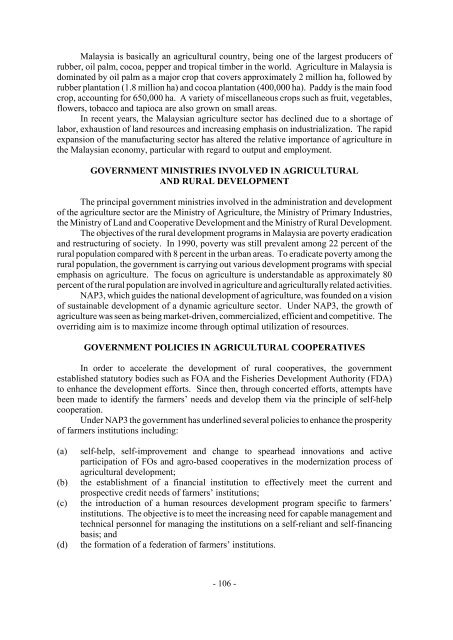Development of Agribusiness Enterprises - Asian Productivity ...
Development of Agribusiness Enterprises - Asian Productivity ...
Development of Agribusiness Enterprises - Asian Productivity ...
You also want an ePaper? Increase the reach of your titles
YUMPU automatically turns print PDFs into web optimized ePapers that Google loves.
Malaysia is basically an agricultural country, being one <strong>of</strong> the largest producers <strong>of</strong><br />
rubber, oil palm, cocoa, pepper and tropical timber in the world. Agriculture in Malaysia is<br />
dominated by oil palm as a major crop that covers approximately 2 million ha, followed by<br />
rubber plantation (1.8 million ha) and cocoa plantation (400,000 ha). Paddy is the main food<br />
crop, accounting for 650,000 ha. A variety <strong>of</strong> miscellaneous crops such as fruit, vegetables,<br />
flowers, tobacco and tapioca are also grown on small areas.<br />
In recent years, the Malaysian agriculture sector has declined due to a shortage <strong>of</strong><br />
labor, exhaustion <strong>of</strong> land resources and increasing emphasis on industrialization. The rapid<br />
expansion <strong>of</strong> the manufacturing sector has altered the relative importance <strong>of</strong> agriculture in<br />
the Malaysian economy, particular with regard to output and employment.<br />
GOVERNMENT MINISTRIES INVOLVED IN AGRICULTURAL<br />
AND RURAL DEVELOPMENT<br />
The principal government ministries involved in the administration and development<br />
<strong>of</strong> the agriculture sector are the Ministry <strong>of</strong> Agriculture, the Ministry <strong>of</strong> Primary Industries,<br />
the Ministry <strong>of</strong> Land and Cooperative <strong>Development</strong> and the Ministry <strong>of</strong> Rural <strong>Development</strong>.<br />
The objectives <strong>of</strong> the rural development programs in Malaysia are poverty eradication<br />
and restructuring <strong>of</strong> society. In 1990, poverty was still prevalent among 22 percent <strong>of</strong> the<br />
rural population compared with 8 percent in the urban areas. To eradicate poverty among the<br />
rural population, the government is carrying out various development programs with special<br />
emphasis on agriculture. The focus on agriculture is understandable as approximately 80<br />
percent <strong>of</strong> the rural population are involved in agriculture and agriculturally related activities.<br />
NAP3, which guides the national development <strong>of</strong> agriculture, was founded on a vision<br />
<strong>of</strong> sustainable development <strong>of</strong> a dynamic agriculture sector. Under NAP3, the growth <strong>of</strong><br />
agriculture was seen as being market-driven, commercialized, efficient and competitive. The<br />
overriding aim is to maximize income through optimal utilization <strong>of</strong> resources.<br />
GOVERNMENT POLICIES IN AGRICULTURAL COOPERATIVES<br />
In order to accelerate the development <strong>of</strong> rural cooperatives, the government<br />
established statutory bodies such as FOA and the Fisheries <strong>Development</strong> Authority (FDA)<br />
to enhance the development efforts. Since then, through concerted efforts, attempts have<br />
been made to identify the farmers’ needs and develop them via the principle <strong>of</strong> self-help<br />
cooperation.<br />
Under NAP3 the government has underlined several policies to enhance the prosperity<br />
<strong>of</strong> farmers institutions including:<br />
(a) self-help, self-improvement and change to spearhead innovations and active<br />
participation <strong>of</strong> FOs and agro-based cooperatives in the modernization process <strong>of</strong><br />
agricultural development;<br />
(b) the establishment <strong>of</strong> a financial institution to effectively meet the current and<br />
prospective credit needs <strong>of</strong> farmers’ institutions;<br />
(c) the introduction <strong>of</strong> a human resources development program specific to farmers’<br />
institutions. The objective is to meet the increasing need for capable management and<br />
technical personnel for managing the institutions on a self-reliant and self-financing<br />
basis; and<br />
(d) the formation <strong>of</strong> a federation <strong>of</strong> farmers’ institutions.<br />
- 106 -
















